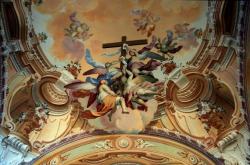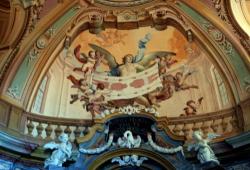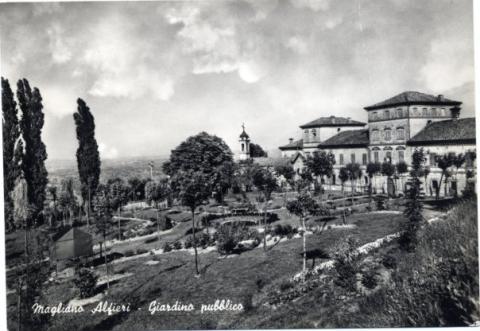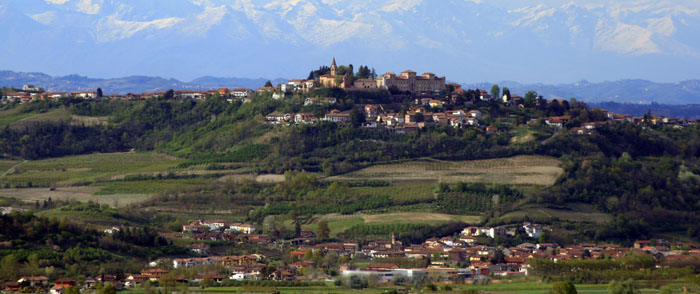

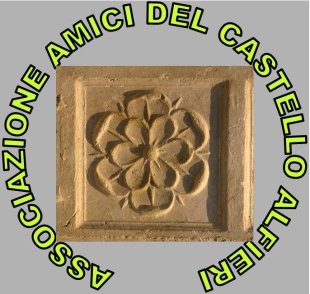
PARK ALFIERI
Main entrance of the castle at the top of the "pot", is the park Alfieri. Perched on top of our hill is planted with a green lawn and bordered with plane trees, pines and limes. There are a small fountain, a picnic area in the game and building an amphitheater.
THE ENTRANCE HALL AND THE GRAND STAIRCASE
The harmonious entrance hall is still crippled by the walls of the former post office, built in the 60s and awaiting removal. Even an adjacent lounge with original eighteenth-century frescoes on the ceiling (now called "eagles") is waiting for restoration: the walls must be removed the plaster that (believe it or not) was applied on the frescoes (always in the 60s ) To adapt to the local housing officer post. Even the grand staircase has been altered on the first floor, entered from a landing in the 60 to give access to one of those apartments and now used as a second access to the "Museum of chalk. " Going up the first piece of art that greets the visitor is the huge niche located on a wall of the staircase. The oculus, oval, contained a bust of Carlo Emanuele Alfieri (1643-1691), who in 1941 was transported to the castle of San Martino Alfieri for safety reasons, because the castle during the war, had become numerous housing military. On 1 January 2000 the City Council has placed in the niche a plaster cast, perfect reproduction of the original bust. Was the son of Carlo Emanuele Catalano (one ended and another began building the castle). The inscription in Latin, commissioned by his son and his widow Eleanor Tana, she says:

THE HALL OF BADGES
The hall occupies the central tower of the castle and is covered by a pavilion vault, the decoration is in stucco plaster in high relief, baroque phenomenon that has been of great importance in the '600 and '700 Asti in Piedmont and in other cities. The stucco reproduce the family crests Alfieri matched (on time and on all four doors) to other arms of noble families related by marriage with it (the marriage was also a way to build alliances of power between families). The hand that decorated the time is the same that worked on the oculus of the staircase, in fact reappear warlike trophies at the sides of the arms, adorned with decorative plants, that remain the same as those of the staircase. A six meters above the first cornice runs a row of windows opened to the outside on the north and south sides, with effect painted trompe l'oeil "on the other two sides. Among the splays of the windows are hanging in festoons stucco depicting bunches of leaves and fruits (as already mentioned, that the complaint clearly wrought its origin Lugano).
At the four corners of the ceiling you see the eagle house Alfieri with the mottos "Tort them hard" ("the offense does not last, " referring to the tragic story of Catalan Alfieri) and "hostile Cruor tinct"("bathed in the blood enemy "spear, probably). At its heart is the great arms of Magliano Alfieri surmounted by the crown marquis: modulated by a cornice in stucco you see the giant eagle wrapped in scrolls and festoons of fruit and written with the mottos "tort it hard" and "fert" (perhaps: "fides ERIT your robur", "faith is your strength"). At the center of the wall opposite the entrance to the City Council has placed the municipal emblem of Magliano in plaster, which tracks the castle of the eagle Alfieri. The installation took place on 1 January 2000, the same day it was put back the cast of the bust of Carlo Emanuele Alfieri oval of the staircase, part of the celebration of the new millennium. Together with the Museum of the plaster casts, the show is the coats of arms, the '90s, the theater's rebirth of the castle: it takes place, in fact, concerts, theatrical performances, exhibitions and conferences.
Notes on the symbol of the eagle: it was a sacred animal to many deities, considered by some cultures the bird solar par excellence. In heraldry can be represented in different positions, but it's always been a symbol of power and kingship. Adopted by many empires and ruling houses, represented the Savoy since sec. XIII. Originated by the eagle of Rome, was restored by Charlemagne and became the symbol of the Empire. He is present also on the emblem of Alfieri, who supported the Ghibellines in the clash with the Guelphs (the allies of the Pope) for power in the town of Asti.
So the decoration is in stucco in 1708 and, despite the imminent baroque, it draws even the seventeenth-century tradition. A sumptuous corniciatura molded (shaped) surrounds the recess resting on a sort of shelf on which are located on the right and left, war trophies (guns, bullets, spears, halberds and flags) and winding branches of laurel. The oval is closed on top with a cornice, on which are perched two eagles, which flanked the blazon of the house. Run around the oval decorated with acanthus. The author of these decorations is still anonymous, but the type of plastic applied decoration refers to plasterers Lugano.



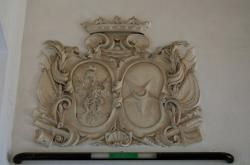
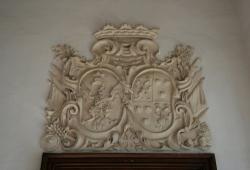
THE CHAPEL FAMILY ALFIERI
We are on the east side of the castle. Through a portal to enter into the sandstone chapel of Alfieri, dedicated to the Holy Crucifix and also known as the Oratory of the Holy Shroud. The mother of Vittorio Alfieri, who spent summers in the castle, got there we could celebrate mass. Today was again desecrated. The decorative style is "Baroque", indicating that the chapel was built in the second half of the 700. Before 1768 (when it was built by Count Giacinto Lodovico Alfieri, who married the mother of Vittorio Alfieri) resulting from pastoral visits in the castle there was another chapel dedicated to St. Joseph (the various uses to which it was intended in time this building have also resulted in internal changes). The chapel is rectangular, a single ship, with circular opening containing the baroque altar in faux marble and stucco, whose sober and refined elegance of design, design of complaint be accomplished architect. Notice the beautiful decorations that adorn it, culminating in two white angels kneeling, masterfully executed and placed on either side of the pediment. At the center is the symbolic pelican, made of soft nature.
From a fake balcony above the altar shows the Holy Shroud of angels and above, in the eye of heaven, it is the dove of the Spirit. On the ceiling of the single nave, an illusive decoration elegant rendition opens up space opening up to show the sky, where angels and to overlook the other angels who go up fast, triumphantly carrying the cross. A riot of angels with the symbols of the Passion is also visible on the painted balconies, which adorn the upper walls, which appear on the fake choirs. False niches are then placed in the spandrels of the dome and they are painted four vases of flowers. All decorations are made with fresh perspectives impressive architectural trompe l'oeil. The chapel is also home to three large paintings on the facts of the life of Christ (The Crucifixion, the altar, Dinner at the house of Simon the leper and the resurrection of Lazarus, the side walls) that have been restored to Aramengo, in the famous laboratory Nicola and reported in the chapel at the end of September 2006..
The paintings and frescoes of the vault are attributed to Pier Paolo Operti, painter Bra '700, who has been active in Bra, Saluzzo, Cherasco, La Morra, etc.. A confirmation of the allocation may claim a stylistic comparison with other works, in particular with the "triumph of Santa Chiara" on the ceiling of the church of Santa Chiara at Bra, which refers to this "triumph of the Cross. " It is also true that the Operti at that time was present in the parish of Magliano Alfieri invoice for the painting "Madonna of the Rosary", a work now unfortunately lost. The chapel, like the castle, was the object of attention of the Group of Maglianesi Nostra and Italy in the early '70s. At that time it was used as storage for pasta, rice, etc.., a shop next door. The restoration occurred in 1994, but the intervention was very slight: the engineers were surprised to find, beneath the fat layer of dust, the colors almost intact eighteenth century, which still affect the visitors for their vivacity, after two and a half centuries .
Notes on the pelican: it is a water bird, which was believed legendary loved so much to feed their brood with his blood flow was tearing his chest to pecking. It is one of the most famous allegory of Christ.

